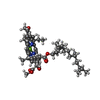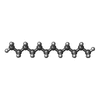[English] 日本語
 Yorodumi
Yorodumi- PDB-8jc9: Cryo-EM structure of the LH1 complex from thermochromatium tepidum -
+ Open data
Open data
- Basic information
Basic information
| Entry | Database: PDB / ID: 8jc9 | |||||||||
|---|---|---|---|---|---|---|---|---|---|---|
| Title | Cryo-EM structure of the LH1 complex from thermochromatium tepidum | |||||||||
 Components Components |
| |||||||||
 Keywords Keywords | PHOTOSYNTHESIS / LH1 COMPLEX | |||||||||
| Function / homology |  Function and homology information Function and homology informationorganelle inner membrane / plasma membrane light-harvesting complex / bacteriochlorophyll binding / : / photosynthesis, light reaction / metal ion binding / plasma membrane Similarity search - Function | |||||||||
| Biological species |  Thermochromatium tepidum (bacteria) Thermochromatium tepidum (bacteria) | |||||||||
| Method | ELECTRON MICROSCOPY / single particle reconstruction / cryo EM / Resolution: 3.32 Å | |||||||||
 Authors Authors | Wang, G.-L. / Yan, Y.-H. / Yu, L.-J. | |||||||||
| Funding support |  China, 2items China, 2items
| |||||||||
 Citation Citation |  Journal: Biochim Biophys Acta Bioenerg / Year: 2024 Journal: Biochim Biophys Acta Bioenerg / Year: 2024Title: Molecular structure and characterization of the Thermochromatium tepidum light-harvesting 1 photocomplex produced in a foreign host. Authors: Yi-Hao Yan / Guang-Lei Wang / Xing-Yu Yue / Fei Ma / Michael T Madigan / Zheng-Yu Wang-Otomo / Mei-Juan Zou / Long-Jiang Yu /    Abstract: Purple phototrophic bacteria possess light-harvesting 1 and reaction center (LH1-RC) core complexes that play a key role in converting solar energy to chemical energy. High-resolution structures of ...Purple phototrophic bacteria possess light-harvesting 1 and reaction center (LH1-RC) core complexes that play a key role in converting solar energy to chemical energy. High-resolution structures of LH1-RC and RC complexes have been intensively studied and have yielded critical insight into the architecture and interactions of their proteins, pigments, and cofactors. Nevertheless, a detailed picture of the structure and assembly of LH1-only complexes is lacking due to the intimate association between LH1 and the RC. To study the intrinsic properties and structure of an LH1-only complex, a genetic system was constructed to express the Thermochromatium (Tch.) tepidum LH1 complex heterologously in a modified Rhodospirillum rubrum mutant strain. The heterologously expressed Tch. tepidum LH1 complex was isolated in a pure form free of the RC and exhibited the characteristic absorption properties of Tch. tepidum. Cryo-EM structures of the LH1-only complexes revealed a closed circular ring consisting of either 14 or 15 αβ-subunits, making it the smallest completely closed LH1 complex discovered thus far. Surprisingly, the Tch. tepidum LH1-only complex displayed even higher thermostability than that of the native LH1-RC complex. These results reveal previously unsuspected plasticity of the LH1 complex, provide new insights into the structure and assembly of the LH1-RC complex, and show how molecular genetics can be exploited to study membrane proteins from phototrophic organisms whose genetic manipulation is not yet possible. | |||||||||
| History |
|
- Structure visualization
Structure visualization
| Structure viewer | Molecule:  Molmil Molmil Jmol/JSmol Jmol/JSmol |
|---|
- Downloads & links
Downloads & links
- Download
Download
| PDBx/mmCIF format |  8jc9.cif.gz 8jc9.cif.gz | 398.8 KB | Display |  PDBx/mmCIF format PDBx/mmCIF format |
|---|---|---|---|---|
| PDB format |  pdb8jc9.ent.gz pdb8jc9.ent.gz | 328.8 KB | Display |  PDB format PDB format |
| PDBx/mmJSON format |  8jc9.json.gz 8jc9.json.gz | Tree view |  PDBx/mmJSON format PDBx/mmJSON format | |
| Others |  Other downloads Other downloads |
-Validation report
| Arichive directory |  https://data.pdbj.org/pub/pdb/validation_reports/jc/8jc9 https://data.pdbj.org/pub/pdb/validation_reports/jc/8jc9 ftp://data.pdbj.org/pub/pdb/validation_reports/jc/8jc9 ftp://data.pdbj.org/pub/pdb/validation_reports/jc/8jc9 | HTTPS FTP |
|---|
-Related structure data
| Related structure data |  36154MC  8jc8C M: map data used to model this data C: citing same article ( |
|---|---|
| Similar structure data | Similarity search - Function & homology  F&H Search F&H Search |
- Links
Links
- Assembly
Assembly
| Deposited unit | 
|
|---|---|
| 1 |
|
- Components
Components
-Protein / Protein/peptide , 2 types, 28 molecules 1357ADFIKOQSUY2468BEGJNPRTVZ
| #1: Protein | Mass: 7034.442 Da / Num. of mol.: 14 / Source method: isolated from a natural source / Source: (natural)  Thermochromatium tepidum (bacteria) / References: UniProt: D2Z0P2 Thermochromatium tepidum (bacteria) / References: UniProt: D2Z0P2#2: Protein/peptide | Mass: 5534.452 Da / Num. of mol.: 14 / Source method: isolated from a natural source / Source: (natural)  Thermochromatium tepidum (bacteria) / References: UniProt: D2Z0P1 Thermochromatium tepidum (bacteria) / References: UniProt: D2Z0P1 |
|---|
-Non-polymers , 4 types, 70 molecules 






| #3: Chemical | ChemComp-BCL / #4: Chemical | ChemComp-CA / #5: Chemical | ChemComp-CRT / #6: Chemical | ChemComp-D12 / |
|---|
-Details
| Has ligand of interest | Y |
|---|---|
| Has protein modification | N |
-Experimental details
-Experiment
| Experiment | Method: ELECTRON MICROSCOPY |
|---|---|
| EM experiment | Aggregation state: PARTICLE / 3D reconstruction method: single particle reconstruction |
- Sample preparation
Sample preparation
| Component | Name: LH1 COMPLEX / Type: COMPLEX / Entity ID: #1-#2 / Source: NATURAL |
|---|---|
| Molecular weight | Experimental value: NO |
| Source (natural) | Organism:  Thermochromatium tepidum (bacteria) Thermochromatium tepidum (bacteria) |
| Buffer solution | pH: 7.5 |
| Specimen | Embedding applied: NO / Shadowing applied: NO / Staining applied: NO / Vitrification applied: YES |
| Vitrification | Cryogen name: ETHANE |
- Electron microscopy imaging
Electron microscopy imaging
| Experimental equipment |  Model: Talos Arctica / Image courtesy: FEI Company |
|---|---|
| Microscopy | Model: FEI TALOS ARCTICA |
| Electron gun | Electron source:  FIELD EMISSION GUN / Accelerating voltage: 300 kV / Illumination mode: FLOOD BEAM FIELD EMISSION GUN / Accelerating voltage: 300 kV / Illumination mode: FLOOD BEAM |
| Electron lens | Mode: BRIGHT FIELD / Nominal defocus max: 2300 nm / Nominal defocus min: 700 nm |
| Image recording | Electron dose: 63.2 e/Å2 / Film or detector model: GATAN K3 (6k x 4k) |
- Processing
Processing
| EM software | Name: PHENIX / Version: 1.19.2_4158: / Category: model refinement | ||||||||||||||||||||||||
|---|---|---|---|---|---|---|---|---|---|---|---|---|---|---|---|---|---|---|---|---|---|---|---|---|---|
| CTF correction | Type: PHASE FLIPPING ONLY | ||||||||||||||||||||||||
| 3D reconstruction | Resolution: 3.32 Å / Resolution method: FSC 0.143 CUT-OFF / Num. of particles: 47987 / Symmetry type: POINT | ||||||||||||||||||||||||
| Refine LS restraints |
|
 Movie
Movie Controller
Controller



 PDBj
PDBj



